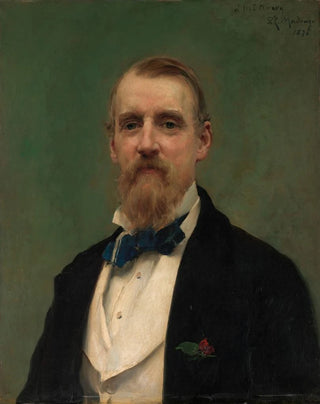Art print | Samuel P. Avery 1822-1904 - Raimundo de Madrazo y Garreta


View from behind

Frame (optional)
Samuel P. Avery 1822-1904 art print - Raimundo de Madrazo y Garreta – Engaging introduction
The Samuel P. Avery 1822-1904 art print by Raimundo de Madrazo y Garreta immerses us in a universe where art transcends time and space. Through this piece, the artist invites us to explore a dialogue between the past and the present, revealing the subtleties of a bygone era while maintaining contemporary relevance. The image emanating from this painting is not merely that of a frozen scene, but a true visual narrative that captures the imagination and encourages contemplation. Entering this pictorial universe, the viewer is transported to a world where each brushstroke tells a story, where emotions are palpable, and where beauty reveals itself in all its forms.
Style and uniqueness of the work
Raimundo de Madrazo y Garreta's style is characterized by finesse and delicacy unique to him. In this piece, he deploys a subtly nuanced color palette, playing with shadows and lights to create an intimate atmosphere. The meticulous details, from drapery to the expressions of the characters, testify to his technical skill and keen sense of observation. Every element of the composition is designed to guide the viewer’s gaze, inviting immersion into the depicted universe. The way human figures interact with their environment reveals a deep understanding of the relationship between man and nature, while also evoking a certain melancholy that resonates with the viewer’s soul.
The artist and his influence
Raimundo de Madrazo y Garreta, a prominent figure of the Spanish school, knew how to mark his era with his exceptional talent. Trained within the artistic circles of his time, he absorbed various influences that shaped his career. His work reflects a constant dialogue between tradition and innovation, between realism and impressionism. His contemporaries often regarded him as a pioneer, capable of capturing the very essence of life through his paintings. De Madrazo also played a crucial role in transmitting his knowledge, training many students who would continue

Matte finish

View from behind

Frame (optional)
Samuel P. Avery 1822-1904 art print - Raimundo de Madrazo y Garreta – Engaging introduction
The Samuel P. Avery 1822-1904 art print by Raimundo de Madrazo y Garreta immerses us in a universe where art transcends time and space. Through this piece, the artist invites us to explore a dialogue between the past and the present, revealing the subtleties of a bygone era while maintaining contemporary relevance. The image emanating from this painting is not merely that of a frozen scene, but a true visual narrative that captures the imagination and encourages contemplation. Entering this pictorial universe, the viewer is transported to a world where each brushstroke tells a story, where emotions are palpable, and where beauty reveals itself in all its forms.
Style and uniqueness of the work
Raimundo de Madrazo y Garreta's style is characterized by finesse and delicacy unique to him. In this piece, he deploys a subtly nuanced color palette, playing with shadows and lights to create an intimate atmosphere. The meticulous details, from drapery to the expressions of the characters, testify to his technical skill and keen sense of observation. Every element of the composition is designed to guide the viewer’s gaze, inviting immersion into the depicted universe. The way human figures interact with their environment reveals a deep understanding of the relationship between man and nature, while also evoking a certain melancholy that resonates with the viewer’s soul.
The artist and his influence
Raimundo de Madrazo y Garreta, a prominent figure of the Spanish school, knew how to mark his era with his exceptional talent. Trained within the artistic circles of his time, he absorbed various influences that shaped his career. His work reflects a constant dialogue between tradition and innovation, between realism and impressionism. His contemporaries often regarded him as a pioneer, capable of capturing the very essence of life through his paintings. De Madrazo also played a crucial role in transmitting his knowledge, training many students who would continue






